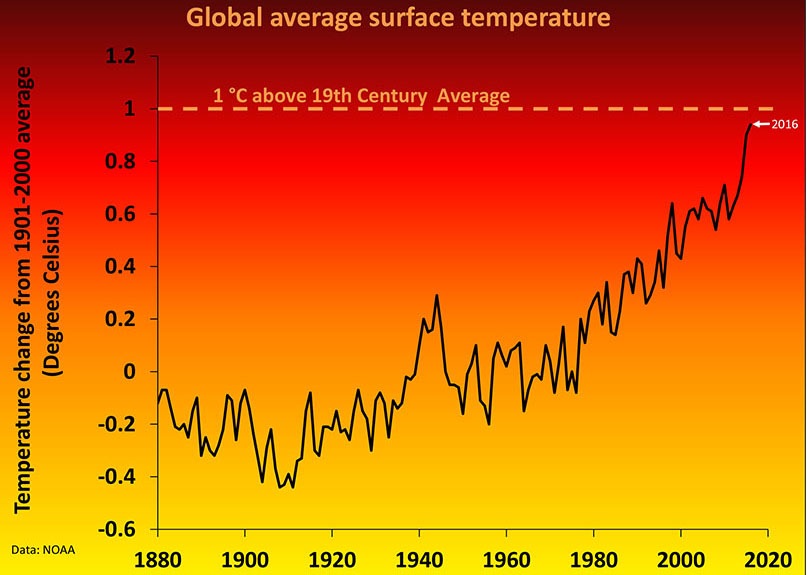
Over the past few years temperature in summer has been rising extraordinarily extremely . Places where summer temperature rarely crossed 26 degrees are now seeing temperatures hovering at around 40 degrees with increasing number of hot days.
The global average summer temperature has seen a rise of 0.4 degrees and the rate of temperature increase has nearly doubled over the last 50 years.
Why is summer getting hotter?
This dramatic increase in the temperature during summer is the consequence of global warming.
Global warming is the unusual increase in Earth’s average surface temperature primarily caused due to greenhouse gases. The more greenhouse gases in the atmosphere, the more warming that happens.
The greenhouse gases include carbon dioxide (CO2), methane (CH4), nitrous oxides (N2O), chlorofluorocarbons (CFC’s), water vapor (H2O), ozone (O3) and Hydrofluorocarbons (HCFCs and HFCs).
These gases have the property to trap some of the solar radiation entering the earth’s atmosphere. A certain concentration of greenhouse gases is essential to keep the earth warmer in order to sustain life. But their increased concentration results in more heat being trapped in the atmosphere.
The net effect is the gradual heating of the Earth’s atmosphere and an increase in surface temperature during the summer.

Let’s look at the factors that contribute to increasing concentration of greenhouse gases and result in higher summer temperature:
1. Burning of Fossil fuels :
- For electricity –
Electricity generation is one of the main cause of carbon pollution. 86% of our electricity comes from burning coal and other gases, while only 14% comes from renewable energy sources like hydro, wind and solar energy. Energy demand rises in summer due to increased use of ACs and air coolers which causes more greenhouse gases to be released.
- For travel and transportation –
A majority of vehicles are fueled via fossil fuels (like gasoline) and burning these releases carbon and other pollutants which increases the concentration of greenhouse gases in the atmosphere.
2. Deforestation :
Trees help in regulating the temperature because they absorb carbon-dioxide from the air and release oxygen. Further, they also act as a natural air conditioner due to evaporation.
But large acres of forests are cleared every year, in order to harvest wood for making paper, to get clear land for farming and also to make way for residential and industrial areas.
About one-fifth of global greenhouse gas pollution comes from deforestation, making deforestation the second leading cause of increasing temperature.
3. Agriculture and farming :
Livestock like sheep, cow and rice productions produce methane. When livestock is grazed at a large scale the amount of methane produced is a big contributor to global warming.
Also, the use of nitrogen fertilizers during agriculture adds nitrogen oxides in the atmosphere which also causes global warming.
4. Use of Aerosols
Cooling devices like refrigerators and AC are potent emitters of greenhouse gases, like CO2, methane, and chlorofluorocarbons, which erode the ozone layer and cause warming.
Another factor that adds to the increasing summer temperature is “concretization”.
Every year a large population moves from rural areas to urban areas, and to accommodate more people cities are expanding which leads to the construction of new buildings and roads. The main materials used for construction are concrete, bricks, and asphalts which absorb more and radiate less solar radiation causing the temperature to increase.
Let us discuss the adverse effects this dramatic rise in mercury during summer causes :
- Impact on humans and animals :
- Heat exhaustion and heat stroke: When body temperature increases above 103 Fahrenheit, humans and animals experience heat stroke which results in heavy sweating, dizziness, nausea, cramps, dehydration and weak pulse.
- Heat causes ozone pollution and degrades the air quality, making it harder to breathe. This worsens the condition of people already suffering from asthma and other respiratory conditions.
- Over the past few years, excessive heat has accounted for more deaths annually than combines effects of hurricanes, floods, and lightning.
- High temperature also degrades the water quality which negatively impacts the fish population.
2. Impact on transportation :
- Roads and highways get damaged. Asphalt roads soften and concrete roads tend to explode under extreme temperatures.
- Vehicles often encounter mechanical failures due to increased stress on automobile cooling systems.
- Railway lines get distorted.
- Aircraft lose their lift at high temperature due to which flights have to be canceled, thus affecting the commuters.
3. Impact on water resources :
- As the temperature increases, the water resources start getting dryer due to an increased rate of evaporation.
- High temperature also affects the precipitation pattern resulting in high rainfall (causing floods) or no rainfall (causing droughts) at certain places.
- As the temperature accelerates, so does the rate of melting of snow. As a consequence, the sea level rises, making coastal areas flood prone. As the sea rises, saltwater moves into freshwater areas making it saline and unfit for drinking.
- The untimely melting of snow cover alter the source point of rivers and affects the rate of flow of rivers.
- Groundwater recharge is also affected by a reduction in the availability of groundwater for drinking water in some regions.
- High temperatures are also linked to rampant algae growth, badly affecting the aquatic ecosystem.
4. Impact on agriculture :
- High temperature changes the nutrient level, water availability, soil moisture, and other necessary conditions to grow crops.
- A high concentration of CO2 in atmosphere and salt in soil affects the crop yields.
- Extreme temperature makes the soil dry and saline (due to floods) thereby reducing the yield.
- Many weeds, pests, and fungi thrive under warmer temperatures and deteriorate the nutritional value of crops and pose a potential threat to human health.
5. Impact on energy :
- The electric transmission system gets impacted as power lines sag in high temperatures.
- The increased demand for electricity means high electricity bills.
- Extreme temperature also reduces the efficiency of various energy power plants as they require water for cooling.
- Rising temperature results in increased evaporation which may increase the need for energy-intensive methods of providing water. For example, desalinization plants that convert salt water into freshwater consume a lot of energy.
Considering the detrimental effects the increased temperature has on our environment, it’s high time we take some serious steps to curb this increasing temperature.
The various steps we can take to improve our community’s resilience to heat waves are:
- Plant more and more trees: Trees provide cooling effect, acts as a natural air purifier, reduces our exposure to harmful UV radiations, and helps in maintaining groundwater level.
- Make use of energy-efficient appliances and equipment: Such appliances help save energy, save money and reduces carbon footprint. ENERGY STAR certified appliances are built to standards making them energy efficient.
- Make more use of renewable energy resources: Installing solar panels to make use of solar energy is the best way of becoming environment friendly.
- Use a fuel-efficient vehicle : Driving hybrid and fully effective vehicle helps save fuel and they generate fewer pollutants. Using cycle to cover short distances can also help reducing energy waste.
- Maximize the use of public transportation: Using buses, trains and carpooling instead of individually driving vehicles will reduce air pollution and help in lowering the temperature.
- Reduce, Reuse, Recycle:
- Reduce: Decreasing our needs to buy new products, results in the generation of less waste.
This prevents the release of toxic gases in air as a result of burning wastes.
- Reuse: Reusing plastic and glass containers, furniture, clothes is the best way to reduce waste and save money.
- Recycle: Recycling paper, aluminum foils, cans, etc. is a great way to help in reducing landfills.
7.Turn off lights and electric appliances when not in use: This will help save fuel and reduce the load on power plants during the summer time.
8. Use sunlight to dry clothes rather than drying them in an automatic washing machine, also instead of using hot water from geysers bathe from cold water during summer.
9. Eat natural products: Eating more vegetables and less packaged food helps cuts down the energy costs used by factories that produce processed food.
10. Spread awareness and educate people about global warming, it causes and after effects. Using social media and conducting programs to share information for protecting our planet and tell ways in which they can contribute their part in saving energy.
After all the choices that we make today will determine the future of our planet and how its climate will be like.
Let us all individually take responsibility and play our role sincerely by following the above mentioned simple steps to avoid the worst potential consequences of global warming on us as well as our future generation.
Writer Bio :KAVYA KHARE, 20 years old student from Bhopal (Madhya Prazdesh).A participant of International Essay Competition, June, 2019.


